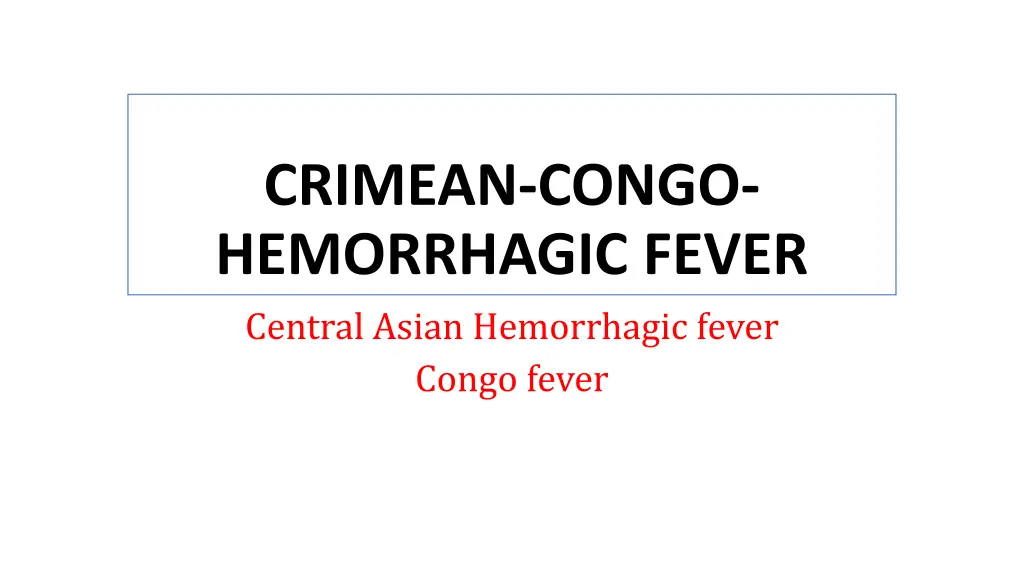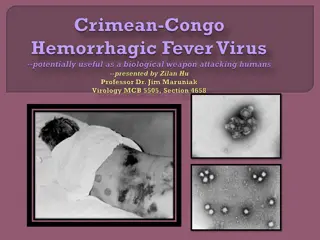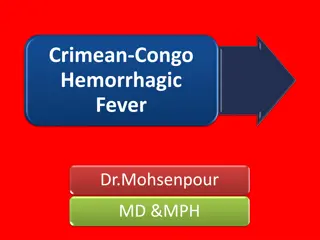
Crimean-Congo Hemorrhagic Fever: Causes, Symptoms, and Transmission
Learn about Crimean-Congo hemorrhagic fever (CCHF), a severe viral disease caused by a tick-borne virus in the Bunyaviridae family. Discover its etiology, geographical distribution, sources, and transmission cycle, as well as the role of animals in its epidemiology. Understand the signs and symptoms of CCHF, its incubation period, and more.
Download Presentation

Please find below an Image/Link to download the presentation.
The content on the website is provided AS IS for your information and personal use only. It may not be sold, licensed, or shared on other websites without obtaining consent from the author. If you encounter any issues during the download, it is possible that the publisher has removed the file from their server.
You are allowed to download the files provided on this website for personal or commercial use, subject to the condition that they are used lawfully. All files are the property of their respective owners.
The content on the website is provided AS IS for your information and personal use only. It may not be sold, licensed, or shared on other websites without obtaining consent from the author.
E N D
Presentation Transcript
CRIMEAN-CONGO- HEMORRHAGIC FEVER Central Asian Hemorrhagic fever Congo fever
Introduction Crimean-Congo hemorrhagic fever (CCHF) is caused by infection with a tick- borne virus (Nairovirus) in the family Bunyaviridae. The disease was first characterized in the Crimea in 1944 and given the name Crimean hemorrhagic fever. It was then later recognized in 1969 as the cause of illness in the Congo, thus resulting in the current name of the disease. The CCHF virus causes severe viral haemorrhagic fever outbreaks, with a case fatality rate of 10 40%.
Etiology Segmented RNA genome (3 segments) Spherical Bilayered lipid enveloped Genus: Nairovirus Family: Bunyaviridae Belongs to the group of tick borne hemorrhagic fever viruses, together with the agents of Omsk hemorrhagic fever and Kyasanur forest disease
Geographical distribution Crimean-Congo hemorrhagic fever is found in Eastern Europe, particularly in the former Soviet Union, Throughout the Mediterranean, In northwestern China, central Asia, Southern Europe, Africa, The Middle East, and the Indian subcontinent
Sources and transmission cycle Natural foci of virus: Steppes, savannahs, semidesert areas foothill biotope Tick: Hyalomma, Dermacentor, Rhipicephalus, and Boophilus Several species of Hyalomma play a prominent role as vectors & reservoirs The larvae & the nymphs of these ticks feeds on hares, hedgehogs, & birds Adult ticks feed on large wild & domestic animals & are easily attracted to man
Role of animals in the epidemiology Vertebrate serve as a reservoir They are simply a food source for the vector ticks Tick act as a vector as well as reservoir Ticks can transmit the infection transovarilly & transstadially
Sign & Symptoms The incubation period is usually 1 to 3 days, with a maximum of nine days after tick bite The incubation period following contact with infected blood or tissues is usually five to six days, with a documented maximum of 13 days Onset of symptoms is sudden, with fever, myalgia, (muscle ache), dizziness, neck pain & stiffness, backache, headache, sore eyes & photophobia (sensitivity to light)
Sign & Symptoms There may be signs of nausea, vomiting, diarrhoea, abdominal pain & sore throat early on, followed by sharp mood swings & confusion After two to four days, the agitation may be replaced by sleepiness, depression & lassitude, The abdominal pain may localize to the upper right quadrant, with detectable hepatomegaly (liver enlargement)
Sign & Symptoms Tachycardia (fast heart rate), lymphadenopathy (enlarged lymph nodes), and a petechial rash (a rash caused by bleeding into the skin) on internal mucosal surfaces, such as in the mouth and throat, and on the skin. The petechiae may give way to larger rashes called ecchymoses, & other haemorrhagic phenomena. There is usually evidence of hepatitis, & severely ill patients may experience rapid kidney deterioration, sudden liver failure or pulmonary failure after the fifth day of illness. CFR: 30%
Diagnosis Isolation of virus: Inoculations of blood of acute phase patients or autopsy material intracerebrally in new borne mice By the cell culture: VERO and CER cell culture Serological diagnosis: Complement fixation test Serum neutralization test Indirect HI Radial gel diffusion ELISA Immunoflurence RT-PCR
Treatment General supportive care with treatment of symptoms is the main approach to managing CCHF in people The antiviral drug ribavirin has been used to treat CCHF infection with apparent benefit. Both oral and intravenous formulations seem to be effective.
Control There is no vaccine available for either people or animals ( An inactivated, mouse brain-derived vaccine against CCHF has been developed and used on a small scale in eastern Europe, there is currently no safe and effective vaccine widely available for human use) Control of ticks population & tick bite: acaricides Isolation of patients Tests on patient samples present an extreme biohazard risk and should only be conducted under maximum biological containment conditions. Proper disinfection: blood from the infected patients may be treated with chlorinated disinfectants PPE kit required for the health care workers
Control Reducing the risk of tick-to-human transmission: wear protective clothing (long sleeves, long trousers); wear light coloured clothing to allow easy detection of ticks on the clothes; use approved acaricides (chemicals intended to kill ticks) on clothing; use approved repellent on the skin and clothing; regularly examine clothing and skin for ticks; if found, remove them safely; seek to eliminate or control tick infestations on animals or in stables and barns; and avoid areas where ticks are abundant and seasons when they are most active.
Control Reducing the risk of animal-to-human transmission: wear gloves and other protective clothing while handling animals or their tissues in endemic areas, notably during slaughtering, butchering and culling procedures in slaughterhouses or at home; quarantine animals before they enter slaughterhouses or routinely treat animals with pesticides two weeks prior to slaughter.
Control Reducing the risk of human-to-human transmission in the community: avoid close physical contact with CCHF-infected people; wear gloves and protective equipment when taking care of ill people; wash hands regularly after caring for or visiting ill people.


